Leadership Practices of Nelson Mandela in 'Playing the Enemy' and 'Invictus'
VerifiedAdded on 2023/05/30
|13
|4094
|358
AI Summary
This article discusses the leadership practices of Nelson Mandela in 'Playing the Enemy' and 'Invictus' and how he was able to unite a nation torn by apartheid through the sport of rugby. It explores how his leadership traits and actions relate to different leadership theories, including the Great Man Theory, Trait Theory, Participative Theory, and Transformational Leadership. The article also includes a reflection on the lessons learned and overall experience.
Contribute Materials
Your contribution can guide someone’s learning journey. Share your
documents today.
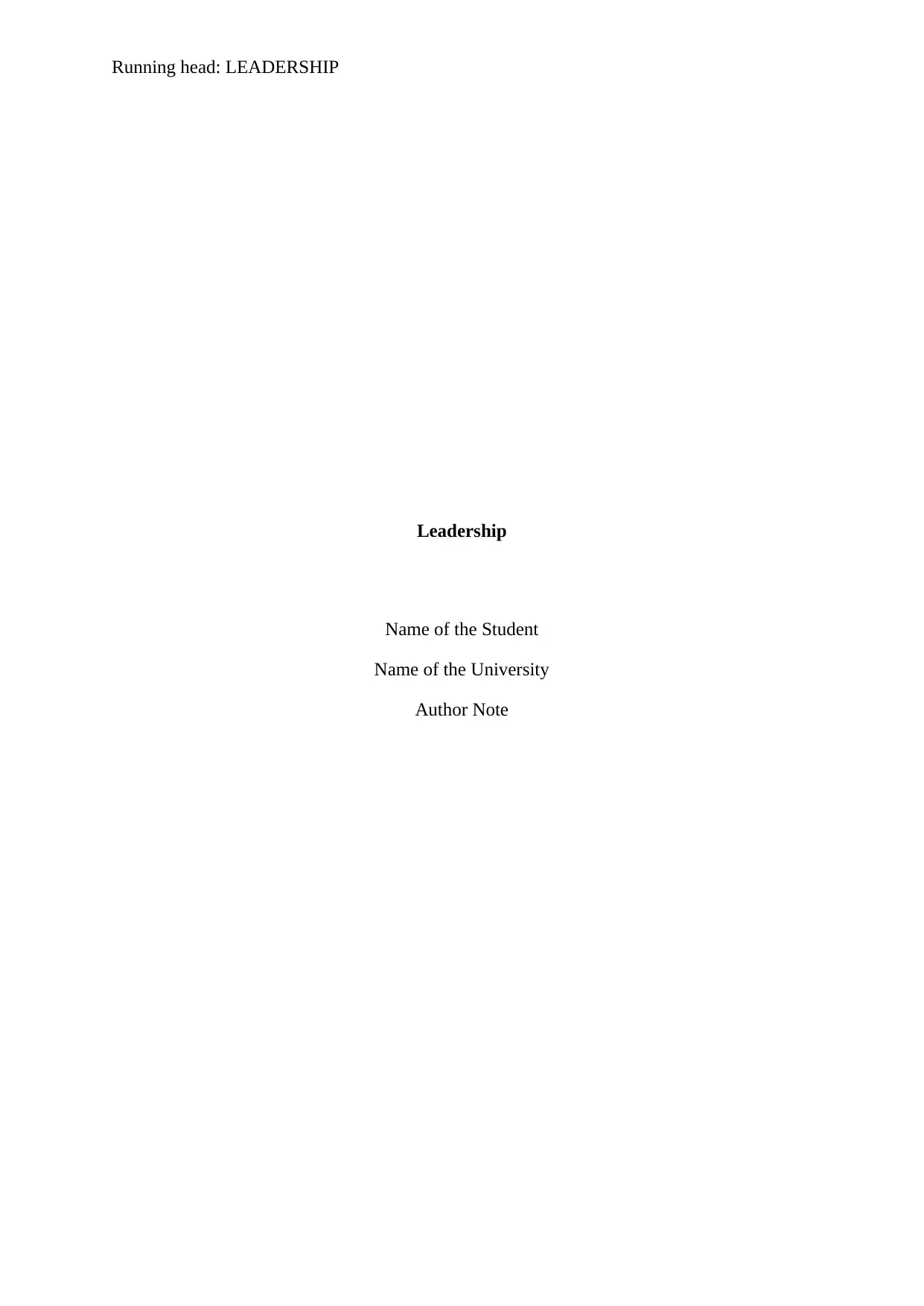
Running head: LEADERSHIP
Leadership
Name of the Student
Name of the University
Author Note
Leadership
Name of the Student
Name of the University
Author Note
Secure Best Marks with AI Grader
Need help grading? Try our AI Grader for instant feedback on your assignments.

1LEADERSHIP
Introduction:
The ability to lead people towards a common goal, motivate and inspire them and is
committed towards a cause and takes responsibility as well as ownership or accountability of
the managerial decisions and performance of the team. Through leadership, individuals can
improve coordination, creativity and innovation within the team and help support better
performance (Fairhurst & Connaughton, 2014). A leader can take several roles, including that
of a mentor, motivator, coach, visionary, providing strategic directions and also help the team
to grow and learn, delegating important tasks to the members and instill the values of
integrity, accountability, clarity, cohesion, cooperation, mutual respect, honesty, creativity,
loyalty, courage and positivity in the team (White et al., 2016). In a social context, a leader
aims to develop collaboration, education and engagement in order to bring about an overall
social development (Haslam & Turner, 2014).
In the book ‘Playing the enemy’ written by John Carlin describes how Nelson
Mandela was able to unite the people torn by apartheid, getting everyone to cheer to the
national rugby team and motivating the national team to defeat the world ruby champions to
become the best team in the world (Carlin, 2008). The same story was also portrayed in the
Hollywood film ‘Invictus’ directed by Clint Eastwood in 2009, named after the poem that
inspired Mr. Mandela himself (Eastwood, 2009; Theresia & Meisuri, 2013; Pietersen, 2015).
Discussed below is how Mr. Mandela used leadership practices to bring cohesion and
lead his people towards a common vision of a nation united. How such a vision shaped the
mindsets of the national rugby team of South Africa as well as all the citizens, and how such
leadership traits and actions could be related to different leadership theories by relating the
leadership styles exhibited by Nelson Mandela described in the Movie Invictus and the book
‘Playing the Enemy’ (Pietersen, 2015).
Introduction:
The ability to lead people towards a common goal, motivate and inspire them and is
committed towards a cause and takes responsibility as well as ownership or accountability of
the managerial decisions and performance of the team. Through leadership, individuals can
improve coordination, creativity and innovation within the team and help support better
performance (Fairhurst & Connaughton, 2014). A leader can take several roles, including that
of a mentor, motivator, coach, visionary, providing strategic directions and also help the team
to grow and learn, delegating important tasks to the members and instill the values of
integrity, accountability, clarity, cohesion, cooperation, mutual respect, honesty, creativity,
loyalty, courage and positivity in the team (White et al., 2016). In a social context, a leader
aims to develop collaboration, education and engagement in order to bring about an overall
social development (Haslam & Turner, 2014).
In the book ‘Playing the enemy’ written by John Carlin describes how Nelson
Mandela was able to unite the people torn by apartheid, getting everyone to cheer to the
national rugby team and motivating the national team to defeat the world ruby champions to
become the best team in the world (Carlin, 2008). The same story was also portrayed in the
Hollywood film ‘Invictus’ directed by Clint Eastwood in 2009, named after the poem that
inspired Mr. Mandela himself (Eastwood, 2009; Theresia & Meisuri, 2013; Pietersen, 2015).
Discussed below is how Mr. Mandela used leadership practices to bring cohesion and
lead his people towards a common vision of a nation united. How such a vision shaped the
mindsets of the national rugby team of South Africa as well as all the citizens, and how such
leadership traits and actions could be related to different leadership theories by relating the
leadership styles exhibited by Nelson Mandela described in the Movie Invictus and the book
‘Playing the Enemy’ (Pietersen, 2015).
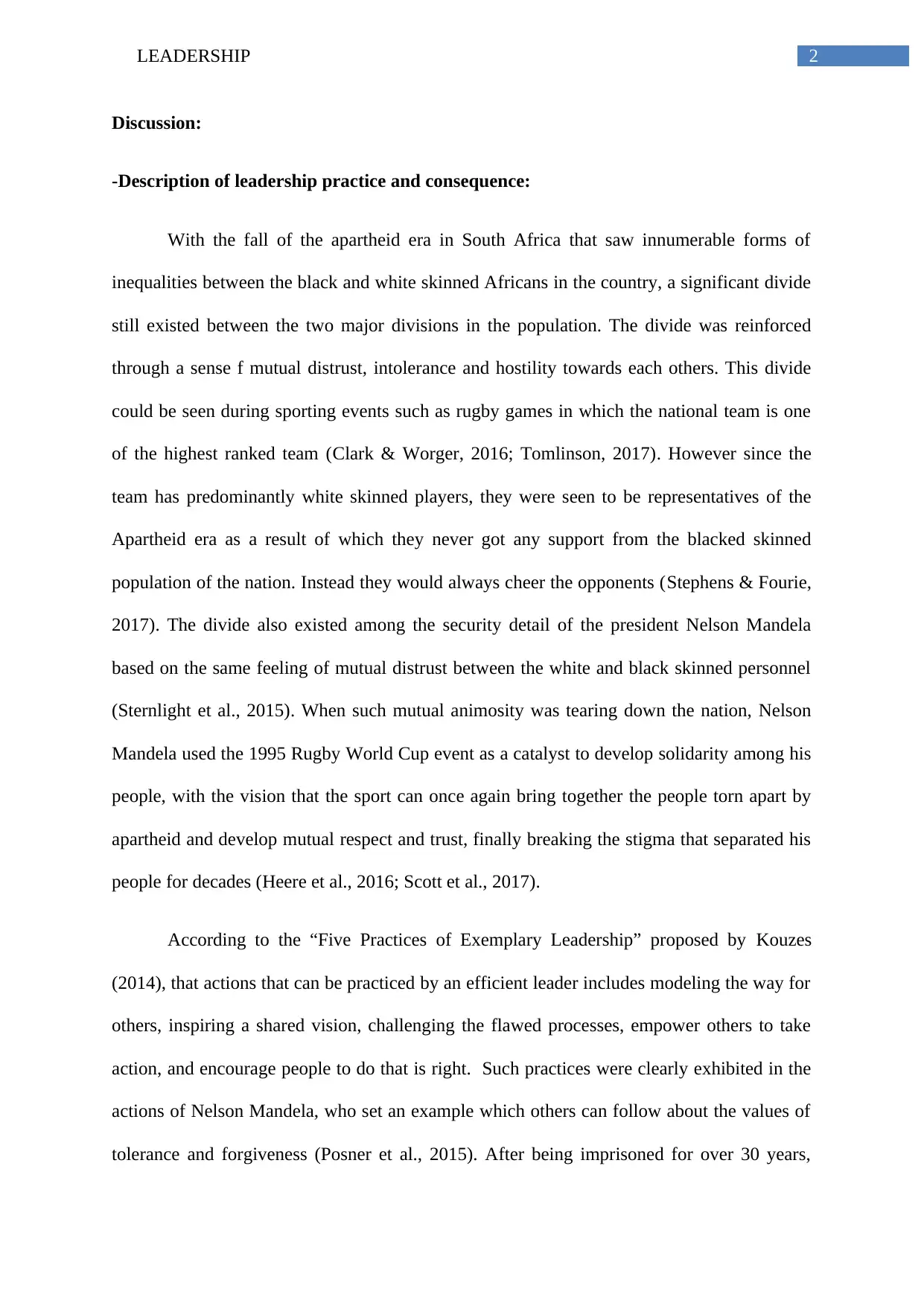
2LEADERSHIP
Discussion:
-Description of leadership practice and consequence:
With the fall of the apartheid era in South Africa that saw innumerable forms of
inequalities between the black and white skinned Africans in the country, a significant divide
still existed between the two major divisions in the population. The divide was reinforced
through a sense f mutual distrust, intolerance and hostility towards each others. This divide
could be seen during sporting events such as rugby games in which the national team is one
of the highest ranked team (Clark & Worger, 2016; Tomlinson, 2017). However since the
team has predominantly white skinned players, they were seen to be representatives of the
Apartheid era as a result of which they never got any support from the blacked skinned
population of the nation. Instead they would always cheer the opponents (Stephens & Fourie,
2017). The divide also existed among the security detail of the president Nelson Mandela
based on the same feeling of mutual distrust between the white and black skinned personnel
(Sternlight et al., 2015). When such mutual animosity was tearing down the nation, Nelson
Mandela used the 1995 Rugby World Cup event as a catalyst to develop solidarity among his
people, with the vision that the sport can once again bring together the people torn apart by
apartheid and develop mutual respect and trust, finally breaking the stigma that separated his
people for decades (Heere et al., 2016; Scott et al., 2017).
According to the “Five Practices of Exemplary Leadership” proposed by Kouzes
(2014), that actions that can be practiced by an efficient leader includes modeling the way for
others, inspiring a shared vision, challenging the flawed processes, empower others to take
action, and encourage people to do that is right. Such practices were clearly exhibited in the
actions of Nelson Mandela, who set an example which others can follow about the values of
tolerance and forgiveness (Posner et al., 2015). After being imprisoned for over 30 years,
Discussion:
-Description of leadership practice and consequence:
With the fall of the apartheid era in South Africa that saw innumerable forms of
inequalities between the black and white skinned Africans in the country, a significant divide
still existed between the two major divisions in the population. The divide was reinforced
through a sense f mutual distrust, intolerance and hostility towards each others. This divide
could be seen during sporting events such as rugby games in which the national team is one
of the highest ranked team (Clark & Worger, 2016; Tomlinson, 2017). However since the
team has predominantly white skinned players, they were seen to be representatives of the
Apartheid era as a result of which they never got any support from the blacked skinned
population of the nation. Instead they would always cheer the opponents (Stephens & Fourie,
2017). The divide also existed among the security detail of the president Nelson Mandela
based on the same feeling of mutual distrust between the white and black skinned personnel
(Sternlight et al., 2015). When such mutual animosity was tearing down the nation, Nelson
Mandela used the 1995 Rugby World Cup event as a catalyst to develop solidarity among his
people, with the vision that the sport can once again bring together the people torn apart by
apartheid and develop mutual respect and trust, finally breaking the stigma that separated his
people for decades (Heere et al., 2016; Scott et al., 2017).
According to the “Five Practices of Exemplary Leadership” proposed by Kouzes
(2014), that actions that can be practiced by an efficient leader includes modeling the way for
others, inspiring a shared vision, challenging the flawed processes, empower others to take
action, and encourage people to do that is right. Such practices were clearly exhibited in the
actions of Nelson Mandela, who set an example which others can follow about the values of
tolerance and forgiveness (Posner et al., 2015). After being imprisoned for over 30 years,

3LEADERSHIP
Nelson Mandela was ready to forgive what was done to him and prevent the past history
continue to divide the people. He also inspired the people as well as the national rugby team
through his own story and a poem by William Earnest Henley, called ‘Invictus’ which have
him his strength to endure the hardships he faced in his life (Tutu, 2018). He envisioned that
through this national support, a nation of passionate but yet divided sports lovers can be
united and thus pave the way towards social cohesion. The following lines by John Carlin in
the book ‘Playing the Enemy’, he quoted “Sport has the power to change the world. It has the
power to inspire, the power to unite people that little else has...It is more powerful in
governments in breaking down racial barriers” to explain Mandela’s vision and strategy to
unite South Africa which he used to inspire the national team to its victory in the world cup
1995 tournament (Carlin, 2008; Sternlight, 2015).
Mandela also was able to challenge the process, looking for opportunities, taking risks
if needed be in order to implement his vision and mission towards social harmony. Thomas
Aquinas once famously quoted “If the highest aim of a captain was to preserve his ship, he
would keep it in port forever” which implies that the ability to take risks is an important
leadership attribute since it helps to develop knowledge and understanding through practical
experience and take difficult decisions which might seem risky at first but has a huge
potential of positive impact (Riggio et al., 2015). In a nation that was divided by the color of
the skin, Mandela was able to engage both the white and black skinned people to a common
cause and thus negotiate a truce between them, which was quoted by John Carlin in his book
as “Most important of all, Mandela stated that the way to a negotiated solution lay in a
simple-sounding formula: reconciling white fears with black aspirations” (Carlin, 2008). At
the core of his action was the ability to inspire the team to give their best performance
defeating every adversary on the way to the World Cup Champion trophy, using the sport to
rally every South Africans of all color to overcome their differences and support the national
Nelson Mandela was ready to forgive what was done to him and prevent the past history
continue to divide the people. He also inspired the people as well as the national rugby team
through his own story and a poem by William Earnest Henley, called ‘Invictus’ which have
him his strength to endure the hardships he faced in his life (Tutu, 2018). He envisioned that
through this national support, a nation of passionate but yet divided sports lovers can be
united and thus pave the way towards social cohesion. The following lines by John Carlin in
the book ‘Playing the Enemy’, he quoted “Sport has the power to change the world. It has the
power to inspire, the power to unite people that little else has...It is more powerful in
governments in breaking down racial barriers” to explain Mandela’s vision and strategy to
unite South Africa which he used to inspire the national team to its victory in the world cup
1995 tournament (Carlin, 2008; Sternlight, 2015).
Mandela also was able to challenge the process, looking for opportunities, taking risks
if needed be in order to implement his vision and mission towards social harmony. Thomas
Aquinas once famously quoted “If the highest aim of a captain was to preserve his ship, he
would keep it in port forever” which implies that the ability to take risks is an important
leadership attribute since it helps to develop knowledge and understanding through practical
experience and take difficult decisions which might seem risky at first but has a huge
potential of positive impact (Riggio et al., 2015). In a nation that was divided by the color of
the skin, Mandela was able to engage both the white and black skinned people to a common
cause and thus negotiate a truce between them, which was quoted by John Carlin in his book
as “Most important of all, Mandela stated that the way to a negotiated solution lay in a
simple-sounding formula: reconciling white fears with black aspirations” (Carlin, 2008). At
the core of his action was the ability to inspire the team to give their best performance
defeating every adversary on the way to the World Cup Champion trophy, using the sport to
rally every South Africans of all color to overcome their differences and support the national
Secure Best Marks with AI Grader
Need help grading? Try our AI Grader for instant feedback on your assignments.
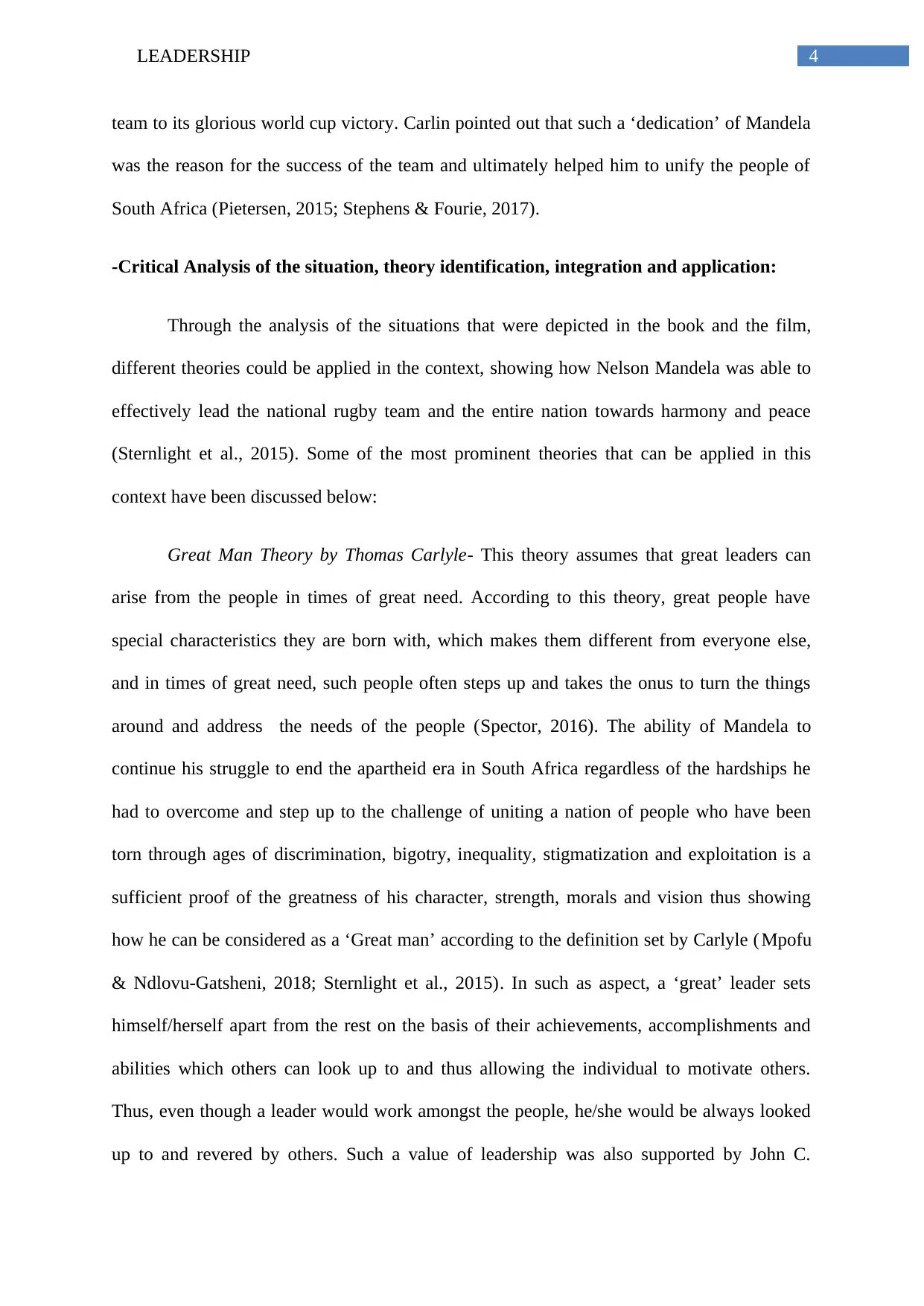
4LEADERSHIP
team to its glorious world cup victory. Carlin pointed out that such a ‘dedication’ of Mandela
was the reason for the success of the team and ultimately helped him to unify the people of
South Africa (Pietersen, 2015; Stephens & Fourie, 2017).
-Critical Analysis of the situation, theory identification, integration and application:
Through the analysis of the situations that were depicted in the book and the film,
different theories could be applied in the context, showing how Nelson Mandela was able to
effectively lead the national rugby team and the entire nation towards harmony and peace
(Sternlight et al., 2015). Some of the most prominent theories that can be applied in this
context have been discussed below:
Great Man Theory by Thomas Carlyle- This theory assumes that great leaders can
arise from the people in times of great need. According to this theory, great people have
special characteristics they are born with, which makes them different from everyone else,
and in times of great need, such people often steps up and takes the onus to turn the things
around and address the needs of the people (Spector, 2016). The ability of Mandela to
continue his struggle to end the apartheid era in South Africa regardless of the hardships he
had to overcome and step up to the challenge of uniting a nation of people who have been
torn through ages of discrimination, bigotry, inequality, stigmatization and exploitation is a
sufficient proof of the greatness of his character, strength, morals and vision thus showing
how he can be considered as a ‘Great man’ according to the definition set by Carlyle ( Mpofu
& Ndlovu-Gatsheni, 2018; Sternlight et al., 2015). In such as aspect, a ‘great’ leader sets
himself/herself apart from the rest on the basis of their achievements, accomplishments and
abilities which others can look up to and thus allowing the individual to motivate others.
Thus, even though a leader would work amongst the people, he/she would be always looked
up to and revered by others. Such a value of leadership was also supported by John C.
team to its glorious world cup victory. Carlin pointed out that such a ‘dedication’ of Mandela
was the reason for the success of the team and ultimately helped him to unify the people of
South Africa (Pietersen, 2015; Stephens & Fourie, 2017).
-Critical Analysis of the situation, theory identification, integration and application:
Through the analysis of the situations that were depicted in the book and the film,
different theories could be applied in the context, showing how Nelson Mandela was able to
effectively lead the national rugby team and the entire nation towards harmony and peace
(Sternlight et al., 2015). Some of the most prominent theories that can be applied in this
context have been discussed below:
Great Man Theory by Thomas Carlyle- This theory assumes that great leaders can
arise from the people in times of great need. According to this theory, great people have
special characteristics they are born with, which makes them different from everyone else,
and in times of great need, such people often steps up and takes the onus to turn the things
around and address the needs of the people (Spector, 2016). The ability of Mandela to
continue his struggle to end the apartheid era in South Africa regardless of the hardships he
had to overcome and step up to the challenge of uniting a nation of people who have been
torn through ages of discrimination, bigotry, inequality, stigmatization and exploitation is a
sufficient proof of the greatness of his character, strength, morals and vision thus showing
how he can be considered as a ‘Great man’ according to the definition set by Carlyle ( Mpofu
& Ndlovu-Gatsheni, 2018; Sternlight et al., 2015). In such as aspect, a ‘great’ leader sets
himself/herself apart from the rest on the basis of their achievements, accomplishments and
abilities which others can look up to and thus allowing the individual to motivate others.
Thus, even though a leader would work amongst the people, he/she would be always looked
up to and revered by others. Such a value of leadership was also supported by John C.
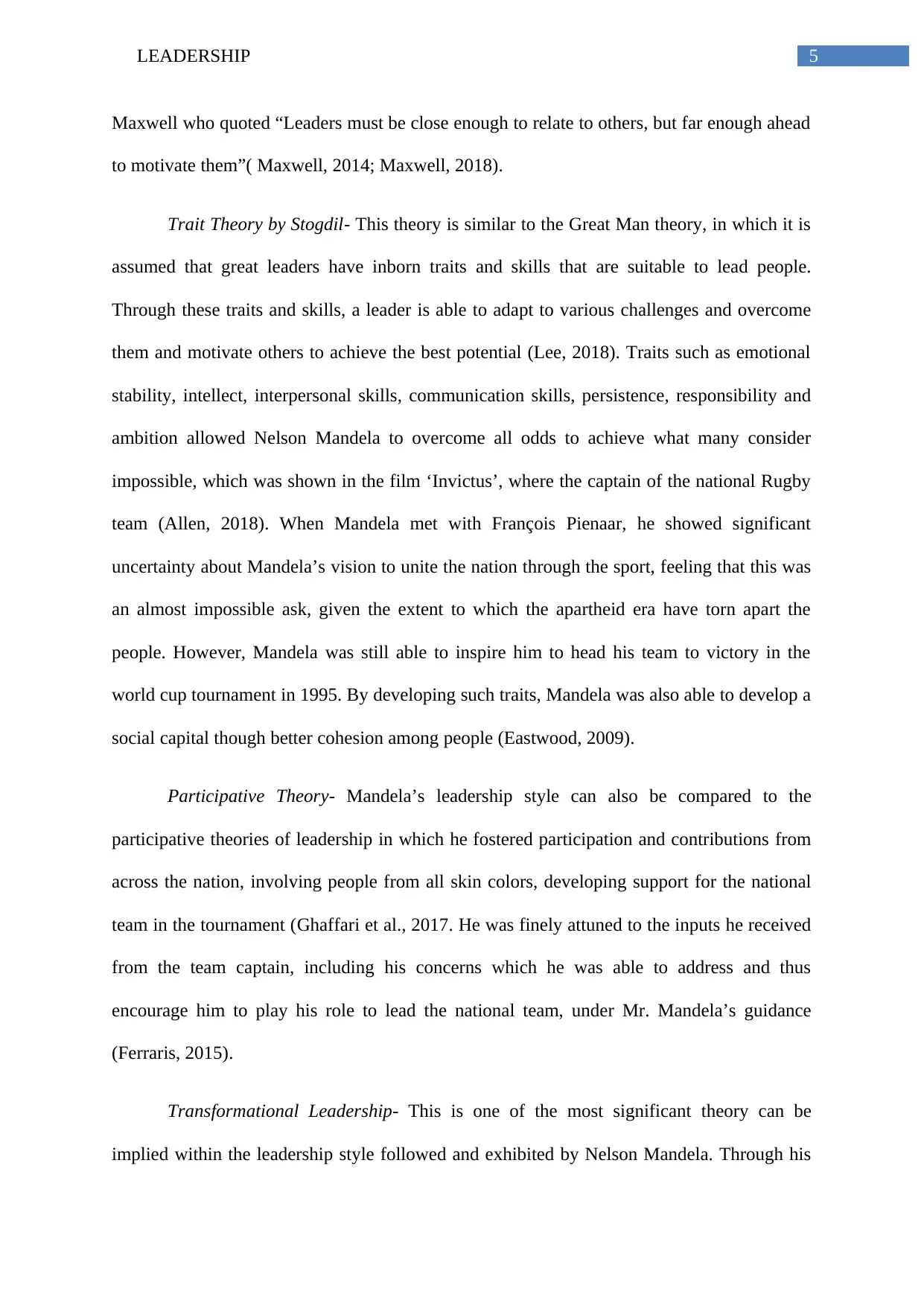
5LEADERSHIP
Maxwell who quoted “Leaders must be close enough to relate to others, but far enough ahead
to motivate them”( Maxwell, 2014; Maxwell, 2018).
Trait Theory by Stogdil- This theory is similar to the Great Man theory, in which it is
assumed that great leaders have inborn traits and skills that are suitable to lead people.
Through these traits and skills, a leader is able to adapt to various challenges and overcome
them and motivate others to achieve the best potential (Lee, 2018). Traits such as emotional
stability, intellect, interpersonal skills, communication skills, persistence, responsibility and
ambition allowed Nelson Mandela to overcome all odds to achieve what many consider
impossible, which was shown in the film ‘Invictus’, where the captain of the national Rugby
team (Allen, 2018). When Mandela met with François Pienaar, he showed significant
uncertainty about Mandela’s vision to unite the nation through the sport, feeling that this was
an almost impossible ask, given the extent to which the apartheid era have torn apart the
people. However, Mandela was still able to inspire him to head his team to victory in the
world cup tournament in 1995. By developing such traits, Mandela was also able to develop a
social capital though better cohesion among people (Eastwood, 2009).
Participative Theory- Mandela’s leadership style can also be compared to the
participative theories of leadership in which he fostered participation and contributions from
across the nation, involving people from all skin colors, developing support for the national
team in the tournament (Ghaffari et al., 2017. He was finely attuned to the inputs he received
from the team captain, including his concerns which he was able to address and thus
encourage him to play his role to lead the national team, under Mr. Mandela’s guidance
(Ferraris, 2015).
Transformational Leadership- This is one of the most significant theory can be
implied within the leadership style followed and exhibited by Nelson Mandela. Through his
Maxwell who quoted “Leaders must be close enough to relate to others, but far enough ahead
to motivate them”( Maxwell, 2014; Maxwell, 2018).
Trait Theory by Stogdil- This theory is similar to the Great Man theory, in which it is
assumed that great leaders have inborn traits and skills that are suitable to lead people.
Through these traits and skills, a leader is able to adapt to various challenges and overcome
them and motivate others to achieve the best potential (Lee, 2018). Traits such as emotional
stability, intellect, interpersonal skills, communication skills, persistence, responsibility and
ambition allowed Nelson Mandela to overcome all odds to achieve what many consider
impossible, which was shown in the film ‘Invictus’, where the captain of the national Rugby
team (Allen, 2018). When Mandela met with François Pienaar, he showed significant
uncertainty about Mandela’s vision to unite the nation through the sport, feeling that this was
an almost impossible ask, given the extent to which the apartheid era have torn apart the
people. However, Mandela was still able to inspire him to head his team to victory in the
world cup tournament in 1995. By developing such traits, Mandela was also able to develop a
social capital though better cohesion among people (Eastwood, 2009).
Participative Theory- Mandela’s leadership style can also be compared to the
participative theories of leadership in which he fostered participation and contributions from
across the nation, involving people from all skin colors, developing support for the national
team in the tournament (Ghaffari et al., 2017. He was finely attuned to the inputs he received
from the team captain, including his concerns which he was able to address and thus
encourage him to play his role to lead the national team, under Mr. Mandela’s guidance
(Ferraris, 2015).
Transformational Leadership- This is one of the most significant theory can be
implied within the leadership style followed and exhibited by Nelson Mandela. Through his
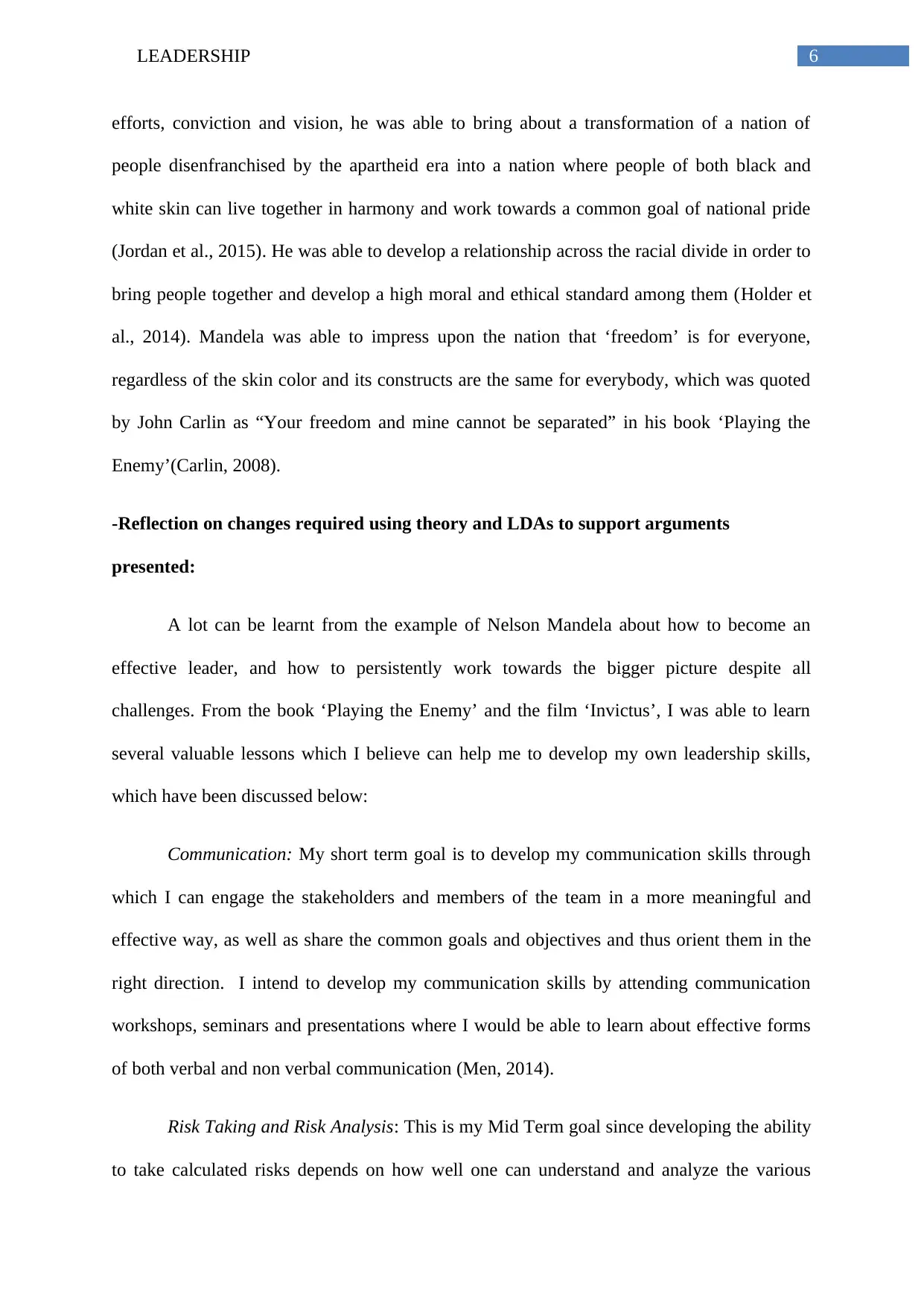
6LEADERSHIP
efforts, conviction and vision, he was able to bring about a transformation of a nation of
people disenfranchised by the apartheid era into a nation where people of both black and
white skin can live together in harmony and work towards a common goal of national pride
(Jordan et al., 2015). He was able to develop a relationship across the racial divide in order to
bring people together and develop a high moral and ethical standard among them (Holder et
al., 2014). Mandela was able to impress upon the nation that ‘freedom’ is for everyone,
regardless of the skin color and its constructs are the same for everybody, which was quoted
by John Carlin as “Your freedom and mine cannot be separated” in his book ‘Playing the
Enemy’(Carlin, 2008).
-Reflection on changes required using theory and LDAs to support arguments
presented:
A lot can be learnt from the example of Nelson Mandela about how to become an
effective leader, and how to persistently work towards the bigger picture despite all
challenges. From the book ‘Playing the Enemy’ and the film ‘Invictus’, I was able to learn
several valuable lessons which I believe can help me to develop my own leadership skills,
which have been discussed below:
Communication: My short term goal is to develop my communication skills through
which I can engage the stakeholders and members of the team in a more meaningful and
effective way, as well as share the common goals and objectives and thus orient them in the
right direction. I intend to develop my communication skills by attending communication
workshops, seminars and presentations where I would be able to learn about effective forms
of both verbal and non verbal communication (Men, 2014).
Risk Taking and Risk Analysis: This is my Mid Term goal since developing the ability
to take calculated risks depends on how well one can understand and analyze the various
efforts, conviction and vision, he was able to bring about a transformation of a nation of
people disenfranchised by the apartheid era into a nation where people of both black and
white skin can live together in harmony and work towards a common goal of national pride
(Jordan et al., 2015). He was able to develop a relationship across the racial divide in order to
bring people together and develop a high moral and ethical standard among them (Holder et
al., 2014). Mandela was able to impress upon the nation that ‘freedom’ is for everyone,
regardless of the skin color and its constructs are the same for everybody, which was quoted
by John Carlin as “Your freedom and mine cannot be separated” in his book ‘Playing the
Enemy’(Carlin, 2008).
-Reflection on changes required using theory and LDAs to support arguments
presented:
A lot can be learnt from the example of Nelson Mandela about how to become an
effective leader, and how to persistently work towards the bigger picture despite all
challenges. From the book ‘Playing the Enemy’ and the film ‘Invictus’, I was able to learn
several valuable lessons which I believe can help me to develop my own leadership skills,
which have been discussed below:
Communication: My short term goal is to develop my communication skills through
which I can engage the stakeholders and members of the team in a more meaningful and
effective way, as well as share the common goals and objectives and thus orient them in the
right direction. I intend to develop my communication skills by attending communication
workshops, seminars and presentations where I would be able to learn about effective forms
of both verbal and non verbal communication (Men, 2014).
Risk Taking and Risk Analysis: This is my Mid Term goal since developing the ability
to take calculated risks depends on how well one can understand and analyze the various
Paraphrase This Document
Need a fresh take? Get an instant paraphrase of this document with our AI Paraphraser
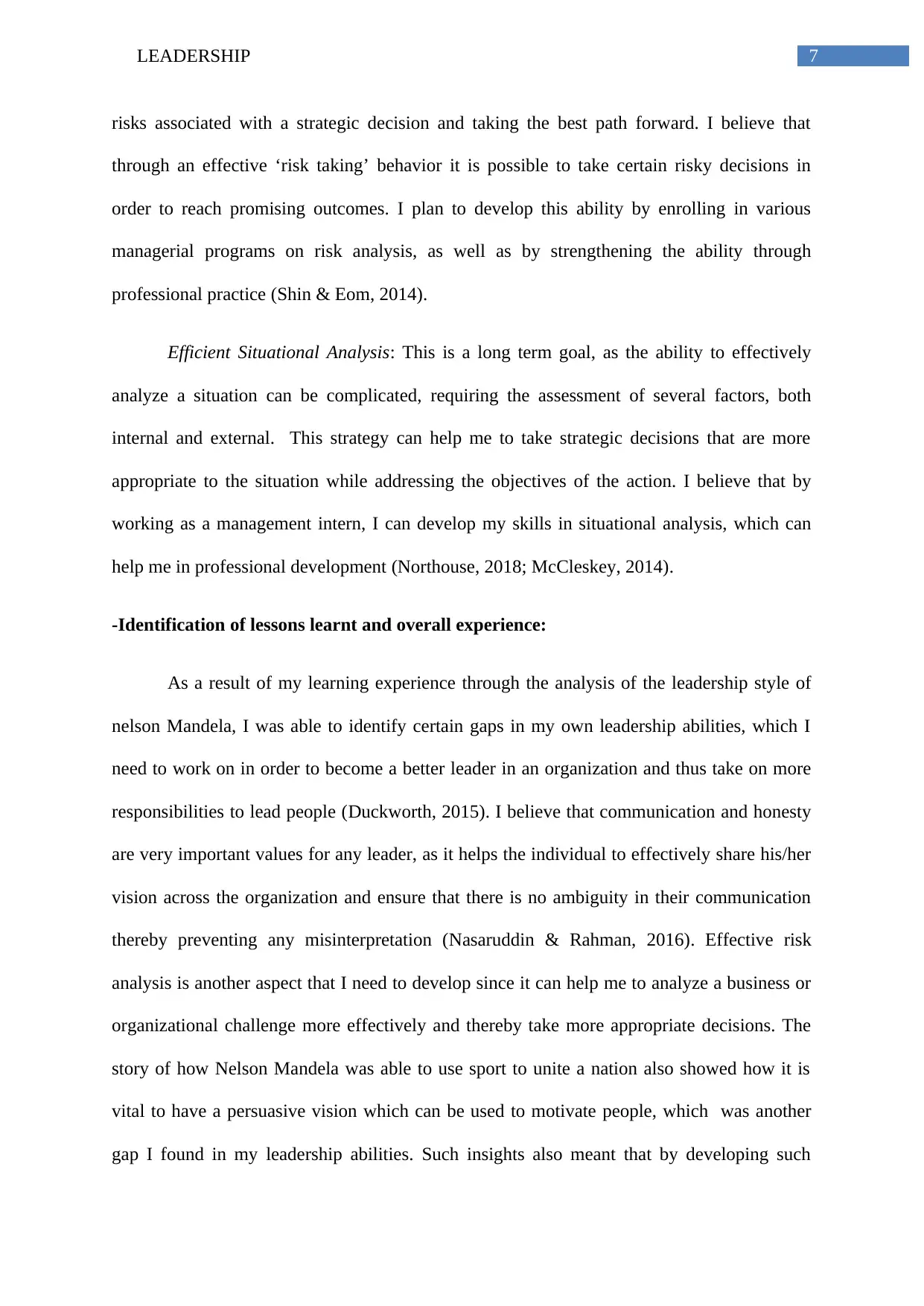
7LEADERSHIP
risks associated with a strategic decision and taking the best path forward. I believe that
through an effective ‘risk taking’ behavior it is possible to take certain risky decisions in
order to reach promising outcomes. I plan to develop this ability by enrolling in various
managerial programs on risk analysis, as well as by strengthening the ability through
professional practice (Shin & Eom, 2014).
Efficient Situational Analysis: This is a long term goal, as the ability to effectively
analyze a situation can be complicated, requiring the assessment of several factors, both
internal and external. This strategy can help me to take strategic decisions that are more
appropriate to the situation while addressing the objectives of the action. I believe that by
working as a management intern, I can develop my skills in situational analysis, which can
help me in professional development (Northouse, 2018; McCleskey, 2014).
-Identification of lessons learnt and overall experience:
As a result of my learning experience through the analysis of the leadership style of
nelson Mandela, I was able to identify certain gaps in my own leadership abilities, which I
need to work on in order to become a better leader in an organization and thus take on more
responsibilities to lead people (Duckworth, 2015). I believe that communication and honesty
are very important values for any leader, as it helps the individual to effectively share his/her
vision across the organization and ensure that there is no ambiguity in their communication
thereby preventing any misinterpretation (Nasaruddin & Rahman, 2016). Effective risk
analysis is another aspect that I need to develop since it can help me to analyze a business or
organizational challenge more effectively and thereby take more appropriate decisions. The
story of how Nelson Mandela was able to use sport to unite a nation also showed how it is
vital to have a persuasive vision which can be used to motivate people, which was another
gap I found in my leadership abilities. Such insights also meant that by developing such
risks associated with a strategic decision and taking the best path forward. I believe that
through an effective ‘risk taking’ behavior it is possible to take certain risky decisions in
order to reach promising outcomes. I plan to develop this ability by enrolling in various
managerial programs on risk analysis, as well as by strengthening the ability through
professional practice (Shin & Eom, 2014).
Efficient Situational Analysis: This is a long term goal, as the ability to effectively
analyze a situation can be complicated, requiring the assessment of several factors, both
internal and external. This strategy can help me to take strategic decisions that are more
appropriate to the situation while addressing the objectives of the action. I believe that by
working as a management intern, I can develop my skills in situational analysis, which can
help me in professional development (Northouse, 2018; McCleskey, 2014).
-Identification of lessons learnt and overall experience:
As a result of my learning experience through the analysis of the leadership style of
nelson Mandela, I was able to identify certain gaps in my own leadership abilities, which I
need to work on in order to become a better leader in an organization and thus take on more
responsibilities to lead people (Duckworth, 2015). I believe that communication and honesty
are very important values for any leader, as it helps the individual to effectively share his/her
vision across the organization and ensure that there is no ambiguity in their communication
thereby preventing any misinterpretation (Nasaruddin & Rahman, 2016). Effective risk
analysis is another aspect that I need to develop since it can help me to analyze a business or
organizational challenge more effectively and thereby take more appropriate decisions. The
story of how Nelson Mandela was able to use sport to unite a nation also showed how it is
vital to have a persuasive vision which can be used to motivate people, which was another
gap I found in my leadership abilities. Such insights also meant that by developing such
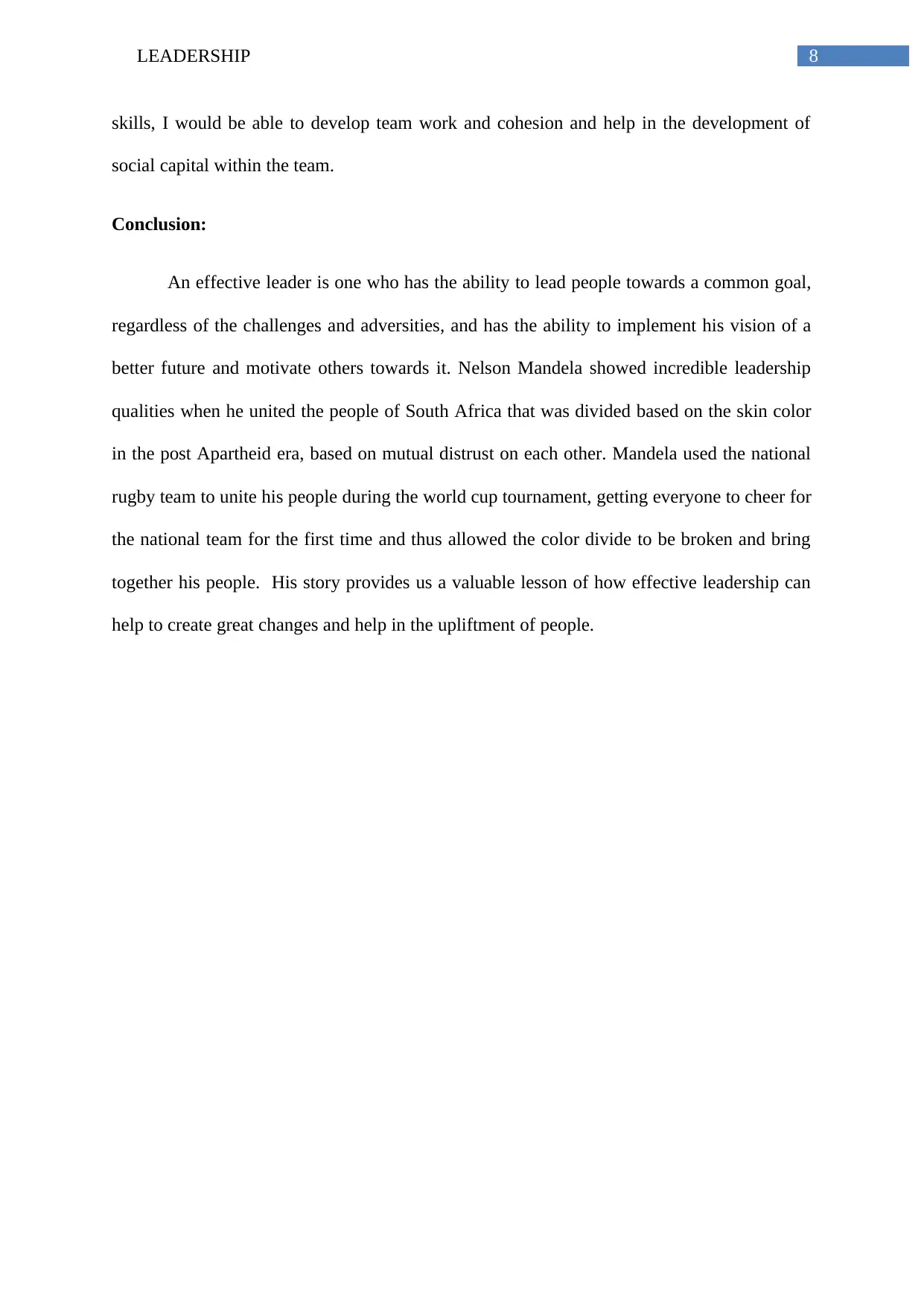
8LEADERSHIP
skills, I would be able to develop team work and cohesion and help in the development of
social capital within the team.
Conclusion:
An effective leader is one who has the ability to lead people towards a common goal,
regardless of the challenges and adversities, and has the ability to implement his vision of a
better future and motivate others towards it. Nelson Mandela showed incredible leadership
qualities when he united the people of South Africa that was divided based on the skin color
in the post Apartheid era, based on mutual distrust on each other. Mandela used the national
rugby team to unite his people during the world cup tournament, getting everyone to cheer for
the national team for the first time and thus allowed the color divide to be broken and bring
together his people. His story provides us a valuable lesson of how effective leadership can
help to create great changes and help in the upliftment of people.
skills, I would be able to develop team work and cohesion and help in the development of
social capital within the team.
Conclusion:
An effective leader is one who has the ability to lead people towards a common goal,
regardless of the challenges and adversities, and has the ability to implement his vision of a
better future and motivate others towards it. Nelson Mandela showed incredible leadership
qualities when he united the people of South Africa that was divided based on the skin color
in the post Apartheid era, based on mutual distrust on each other. Mandela used the national
rugby team to unite his people during the world cup tournament, getting everyone to cheer for
the national team for the first time and thus allowed the color divide to be broken and bring
together his people. His story provides us a valuable lesson of how effective leadership can
help to create great changes and help in the upliftment of people.
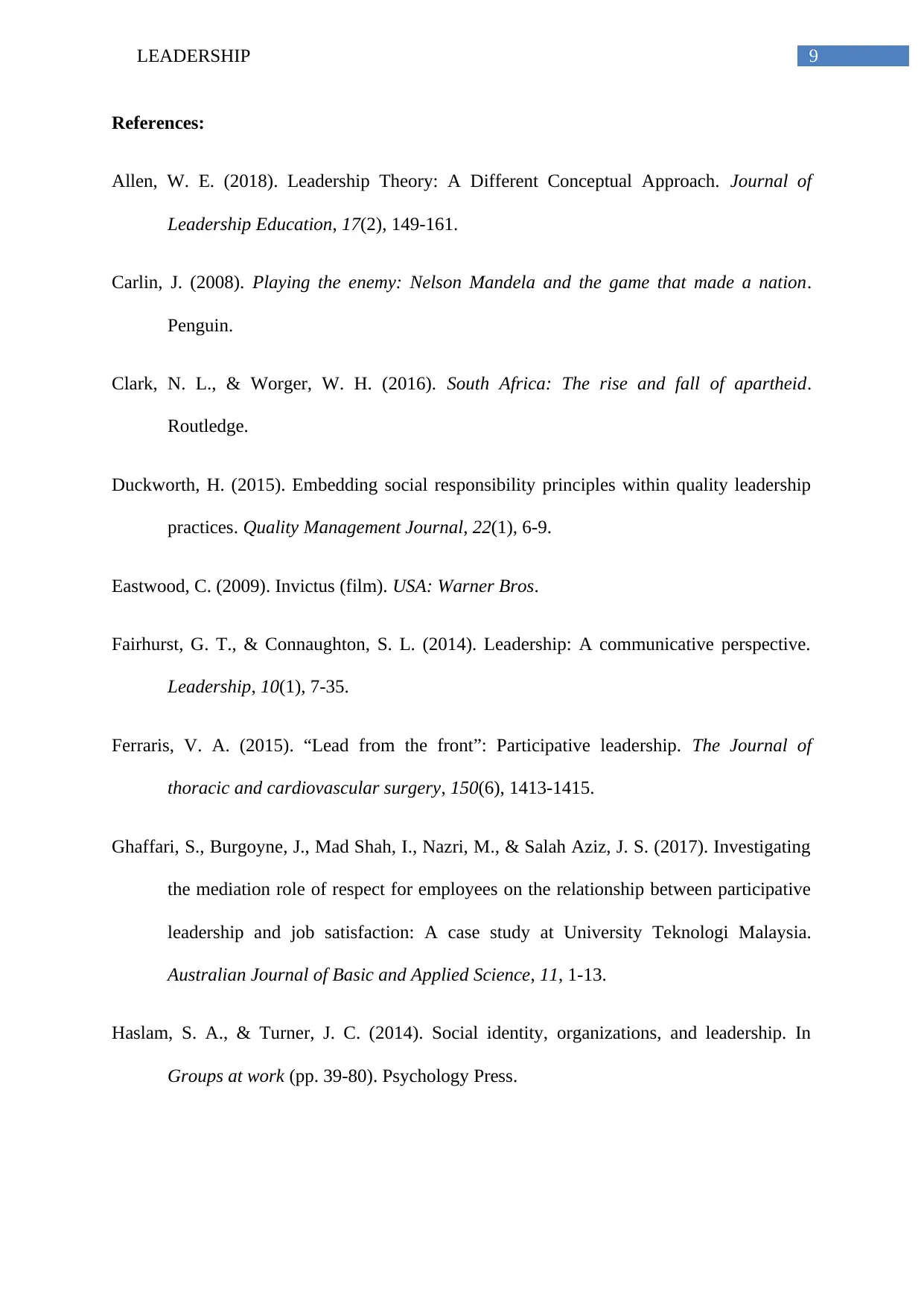
9LEADERSHIP
References:
Allen, W. E. (2018). Leadership Theory: A Different Conceptual Approach. Journal of
Leadership Education, 17(2), 149-161.
Carlin, J. (2008). Playing the enemy: Nelson Mandela and the game that made a nation.
Penguin.
Clark, N. L., & Worger, W. H. (2016). South Africa: The rise and fall of apartheid.
Routledge.
Duckworth, H. (2015). Embedding social responsibility principles within quality leadership
practices. Quality Management Journal, 22(1), 6-9.
Eastwood, C. (2009). Invictus (film). USA: Warner Bros.
Fairhurst, G. T., & Connaughton, S. L. (2014). Leadership: A communicative perspective.
Leadership, 10(1), 7-35.
Ferraris, V. A. (2015). “Lead from the front”: Participative leadership. The Journal of
thoracic and cardiovascular surgery, 150(6), 1413-1415.
Ghaffari, S., Burgoyne, J., Mad Shah, I., Nazri, M., & Salah Aziz, J. S. (2017). Investigating
the mediation role of respect for employees on the relationship between participative
leadership and job satisfaction: A case study at University Teknologi Malaysia.
Australian Journal of Basic and Applied Science, 11, 1-13.
Haslam, S. A., & Turner, J. C. (2014). Social identity, organizations, and leadership. In
Groups at work (pp. 39-80). Psychology Press.
References:
Allen, W. E. (2018). Leadership Theory: A Different Conceptual Approach. Journal of
Leadership Education, 17(2), 149-161.
Carlin, J. (2008). Playing the enemy: Nelson Mandela and the game that made a nation.
Penguin.
Clark, N. L., & Worger, W. H. (2016). South Africa: The rise and fall of apartheid.
Routledge.
Duckworth, H. (2015). Embedding social responsibility principles within quality leadership
practices. Quality Management Journal, 22(1), 6-9.
Eastwood, C. (2009). Invictus (film). USA: Warner Bros.
Fairhurst, G. T., & Connaughton, S. L. (2014). Leadership: A communicative perspective.
Leadership, 10(1), 7-35.
Ferraris, V. A. (2015). “Lead from the front”: Participative leadership. The Journal of
thoracic and cardiovascular surgery, 150(6), 1413-1415.
Ghaffari, S., Burgoyne, J., Mad Shah, I., Nazri, M., & Salah Aziz, J. S. (2017). Investigating
the mediation role of respect for employees on the relationship between participative
leadership and job satisfaction: A case study at University Teknologi Malaysia.
Australian Journal of Basic and Applied Science, 11, 1-13.
Haslam, S. A., & Turner, J. C. (2014). Social identity, organizations, and leadership. In
Groups at work (pp. 39-80). Psychology Press.
Secure Best Marks with AI Grader
Need help grading? Try our AI Grader for instant feedback on your assignments.
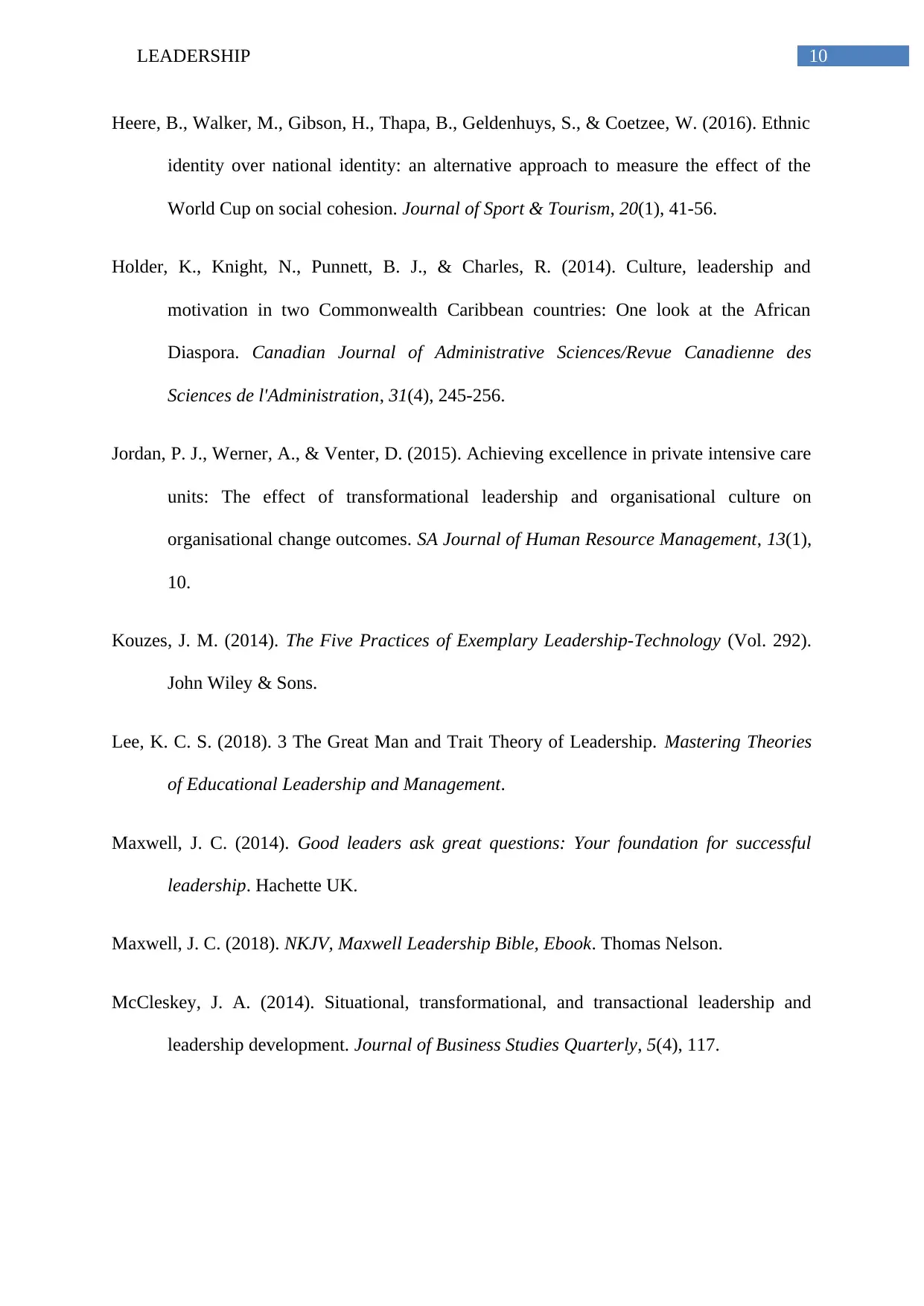
10LEADERSHIP
Heere, B., Walker, M., Gibson, H., Thapa, B., Geldenhuys, S., & Coetzee, W. (2016). Ethnic
identity over national identity: an alternative approach to measure the effect of the
World Cup on social cohesion. Journal of Sport & Tourism, 20(1), 41-56.
Holder, K., Knight, N., Punnett, B. J., & Charles, R. (2014). Culture, leadership and
motivation in two Commonwealth Caribbean countries: One look at the African
Diaspora. Canadian Journal of Administrative Sciences/Revue Canadienne des
Sciences de l'Administration, 31(4), 245-256.
Jordan, P. J., Werner, A., & Venter, D. (2015). Achieving excellence in private intensive care
units: The effect of transformational leadership and organisational culture on
organisational change outcomes. SA Journal of Human Resource Management, 13(1),
10.
Kouzes, J. M. (2014). The Five Practices of Exemplary Leadership-Technology (Vol. 292).
John Wiley & Sons.
Lee, K. C. S. (2018). 3 The Great Man and Trait Theory of Leadership. Mastering Theories
of Educational Leadership and Management.
Maxwell, J. C. (2014). Good leaders ask great questions: Your foundation for successful
leadership. Hachette UK.
Maxwell, J. C. (2018). NKJV, Maxwell Leadership Bible, Ebook. Thomas Nelson.
McCleskey, J. A. (2014). Situational, transformational, and transactional leadership and
leadership development. Journal of Business Studies Quarterly, 5(4), 117.
Heere, B., Walker, M., Gibson, H., Thapa, B., Geldenhuys, S., & Coetzee, W. (2016). Ethnic
identity over national identity: an alternative approach to measure the effect of the
World Cup on social cohesion. Journal of Sport & Tourism, 20(1), 41-56.
Holder, K., Knight, N., Punnett, B. J., & Charles, R. (2014). Culture, leadership and
motivation in two Commonwealth Caribbean countries: One look at the African
Diaspora. Canadian Journal of Administrative Sciences/Revue Canadienne des
Sciences de l'Administration, 31(4), 245-256.
Jordan, P. J., Werner, A., & Venter, D. (2015). Achieving excellence in private intensive care
units: The effect of transformational leadership and organisational culture on
organisational change outcomes. SA Journal of Human Resource Management, 13(1),
10.
Kouzes, J. M. (2014). The Five Practices of Exemplary Leadership-Technology (Vol. 292).
John Wiley & Sons.
Lee, K. C. S. (2018). 3 The Great Man and Trait Theory of Leadership. Mastering Theories
of Educational Leadership and Management.
Maxwell, J. C. (2014). Good leaders ask great questions: Your foundation for successful
leadership. Hachette UK.
Maxwell, J. C. (2018). NKJV, Maxwell Leadership Bible, Ebook. Thomas Nelson.
McCleskey, J. A. (2014). Situational, transformational, and transactional leadership and
leadership development. Journal of Business Studies Quarterly, 5(4), 117.

11LEADERSHIP
Men, L. R. (2014). Strategic internal communication: Transformational leadership,
communication channels, and employee satisfaction. Management Communication
Quarterly, 28(2), 264-284.
Mpofu, B., & Ndlovu-Gatsheni, S. J. (2018). Nelson Mandela’s changing idea of South
Africa. Critical African Studies, 10(2), 173-195.
Nasaruddin, N. A. N., & Rahman, I. A. (2016). Leadership quality for Malaysia Construction
leader to steer a success construction project. In MATEC Web of Conferences (Vol.
47, p. 04006). EDP Sciences.
Northouse, P. G. (2018). Leadership: Theory and practice. Sage publications.
Pietersen, W. (2015). What Nelson Mandela taught the world about leadership. Leader to
Leader, 2015(76), 60-66.
Posner, B. Z. (2015). An investigation into the leadership practices of volunteer leaders.
Leadership & Organization Development Journal, 36(7), 885-898.
Riggio, R. E., Zhu, W., Reina, C., & Maroosis, J. A. (2015). " Virtue-based measurement of
ethical leadership: The Leadership Virtues Questionnaire": Correction to Riggio et al.
(2010).
Scott, O. K. M., Billings, A. C., Harris, J., & Vincent, J. (2017). Using self-categorization
theory to uncover the framing of the 2015 Rugby World Cup: A cross-cultural
comparison of three nations’ newspapers. International Review for the Sociology of
Sport, 1012690217697476.
Men, L. R. (2014). Strategic internal communication: Transformational leadership,
communication channels, and employee satisfaction. Management Communication
Quarterly, 28(2), 264-284.
Mpofu, B., & Ndlovu-Gatsheni, S. J. (2018). Nelson Mandela’s changing idea of South
Africa. Critical African Studies, 10(2), 173-195.
Nasaruddin, N. A. N., & Rahman, I. A. (2016). Leadership quality for Malaysia Construction
leader to steer a success construction project. In MATEC Web of Conferences (Vol.
47, p. 04006). EDP Sciences.
Northouse, P. G. (2018). Leadership: Theory and practice. Sage publications.
Pietersen, W. (2015). What Nelson Mandela taught the world about leadership. Leader to
Leader, 2015(76), 60-66.
Posner, B. Z. (2015). An investigation into the leadership practices of volunteer leaders.
Leadership & Organization Development Journal, 36(7), 885-898.
Riggio, R. E., Zhu, W., Reina, C., & Maroosis, J. A. (2015). " Virtue-based measurement of
ethical leadership: The Leadership Virtues Questionnaire": Correction to Riggio et al.
(2010).
Scott, O. K. M., Billings, A. C., Harris, J., & Vincent, J. (2017). Using self-categorization
theory to uncover the framing of the 2015 Rugby World Cup: A cross-cultural
comparison of three nations’ newspapers. International Review for the Sociology of
Sport, 1012690217697476.
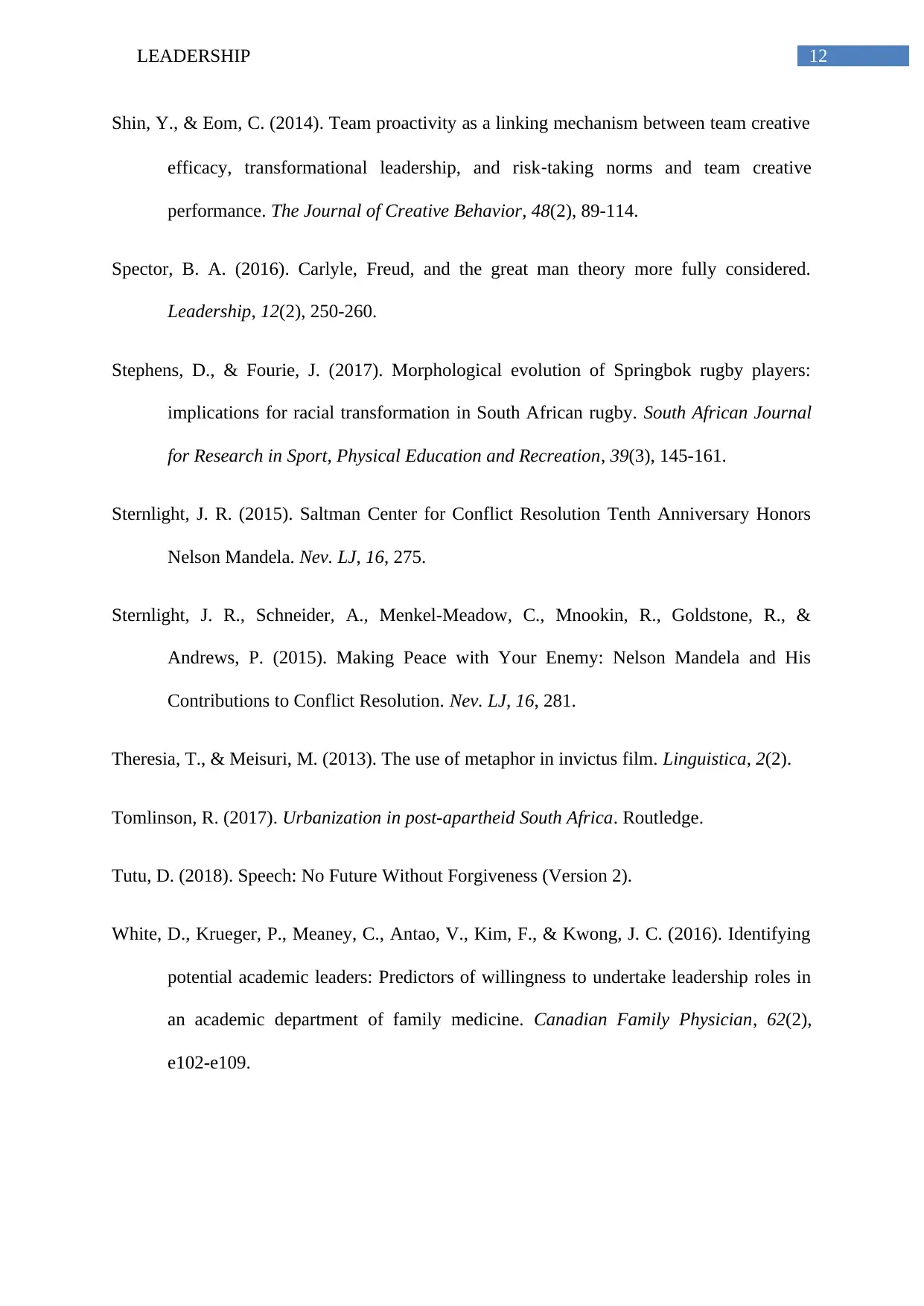
12LEADERSHIP
Shin, Y., & Eom, C. (2014). Team proactivity as a linking mechanism between team creative
efficacy, transformational leadership, and risk‐taking norms and team creative
performance. The Journal of Creative Behavior, 48(2), 89-114.
Spector, B. A. (2016). Carlyle, Freud, and the great man theory more fully considered.
Leadership, 12(2), 250-260.
Stephens, D., & Fourie, J. (2017). Morphological evolution of Springbok rugby players:
implications for racial transformation in South African rugby. South African Journal
for Research in Sport, Physical Education and Recreation, 39(3), 145-161.
Sternlight, J. R. (2015). Saltman Center for Conflict Resolution Tenth Anniversary Honors
Nelson Mandela. Nev. LJ, 16, 275.
Sternlight, J. R., Schneider, A., Menkel-Meadow, C., Mnookin, R., Goldstone, R., &
Andrews, P. (2015). Making Peace with Your Enemy: Nelson Mandela and His
Contributions to Conflict Resolution. Nev. LJ, 16, 281.
Theresia, T., & Meisuri, M. (2013). The use of metaphor in invictus film. Linguistica, 2(2).
Tomlinson, R. (2017). Urbanization in post-apartheid South Africa. Routledge.
Tutu, D. (2018). Speech: No Future Without Forgiveness (Version 2).
White, D., Krueger, P., Meaney, C., Antao, V., Kim, F., & Kwong, J. C. (2016). Identifying
potential academic leaders: Predictors of willingness to undertake leadership roles in
an academic department of family medicine. Canadian Family Physician, 62(2),
e102-e109.
Shin, Y., & Eom, C. (2014). Team proactivity as a linking mechanism between team creative
efficacy, transformational leadership, and risk‐taking norms and team creative
performance. The Journal of Creative Behavior, 48(2), 89-114.
Spector, B. A. (2016). Carlyle, Freud, and the great man theory more fully considered.
Leadership, 12(2), 250-260.
Stephens, D., & Fourie, J. (2017). Morphological evolution of Springbok rugby players:
implications for racial transformation in South African rugby. South African Journal
for Research in Sport, Physical Education and Recreation, 39(3), 145-161.
Sternlight, J. R. (2015). Saltman Center for Conflict Resolution Tenth Anniversary Honors
Nelson Mandela. Nev. LJ, 16, 275.
Sternlight, J. R., Schneider, A., Menkel-Meadow, C., Mnookin, R., Goldstone, R., &
Andrews, P. (2015). Making Peace with Your Enemy: Nelson Mandela and His
Contributions to Conflict Resolution. Nev. LJ, 16, 281.
Theresia, T., & Meisuri, M. (2013). The use of metaphor in invictus film. Linguistica, 2(2).
Tomlinson, R. (2017). Urbanization in post-apartheid South Africa. Routledge.
Tutu, D. (2018). Speech: No Future Without Forgiveness (Version 2).
White, D., Krueger, P., Meaney, C., Antao, V., Kim, F., & Kwong, J. C. (2016). Identifying
potential academic leaders: Predictors of willingness to undertake leadership roles in
an academic department of family medicine. Canadian Family Physician, 62(2),
e102-e109.
1 out of 13
Your All-in-One AI-Powered Toolkit for Academic Success.
+13062052269
info@desklib.com
Available 24*7 on WhatsApp / Email
![[object Object]](/_next/static/media/star-bottom.7253800d.svg)
Unlock your academic potential
© 2024 | Zucol Services PVT LTD | All rights reserved.

